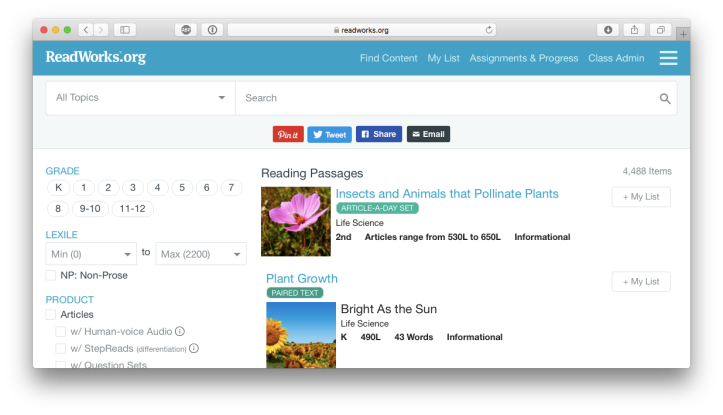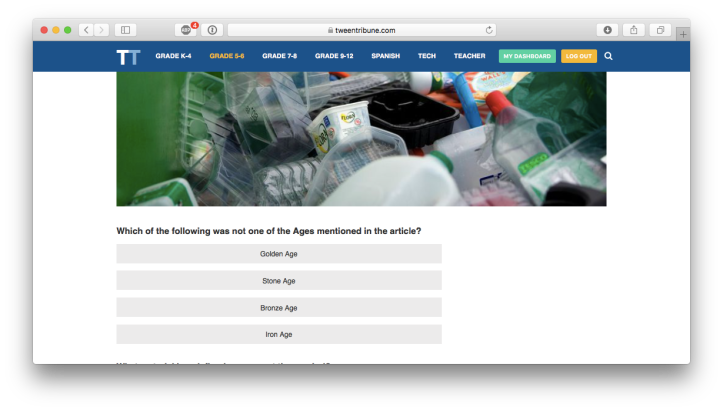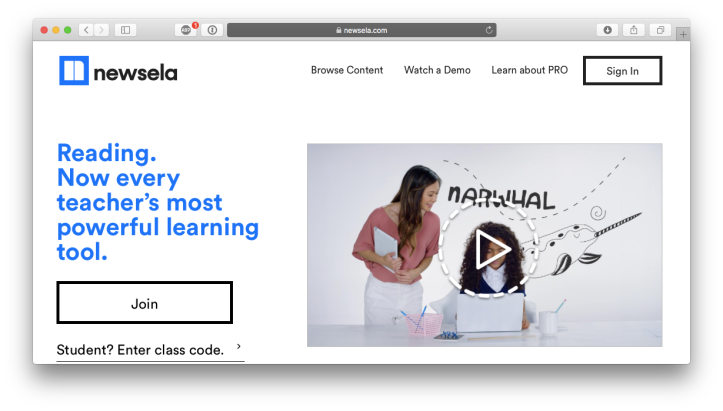
One of the most difficult things to do as an English language instructor is to find level appropriate material, listening or reading, for your students. Attempting to match up topic interests, genre, lexical level, and target grammar is tricky to say the least. You can always create your own reading text, which is what I often end up doing, or you can attempt to find one already created. In the past, this often meant using a coursebook or a graded reader. To be honest, I have found most of them expensive and are often outdated by the time I have them in my hands.
Back in 2012, I found a website that had vocabulary and grammar adjusted news texts and my students loved it. Sadly, as often happens with free sites, it was bought out and made into something else. Last year, I started using two sites with my students that have level appropriate reading material. I thought it might be helpful to share an overview of some of the sites I now use for leveled / graded reading material with my students. This is not meant to be an exhaustive list, but simply what I have found that has worked with my adult English language learners.
All of the sites I will share in this post base their levels using a Lexile score. Since this isn’t commonly used in English language classes, I started to do some investigation into what that would translate into that I might understand a bit better. I came across an article from MetaMetrics appropriately named, “The Common European Framework of Reference for Languages (CEFR) and The Lexile® Framework for Reading.” In this article, MetaMetrics attempted to compare texts graded by the CEFR to a Lexile score. Since the Lexile Framework has a fairly precise way of evaluating text, running a CEFR text through the text should give a fairly accurate comparison. They did this with a large number of texts and found CEFR scores ranged by quite a bit, showing that there is a need for graded reader publishers need to find a way to be more accurate in their scoring system. In the end, this is the chart that MetaMetrics came up with and is what I have posted above my desk at work.

It isn’t very precise, but it gives me a starting point with my classes. I start with a text on the lower end of the scale and work my way up until I find the level of my students. Since each student is different, I keep track of this and attempt to provide level-appropriate text for each student. Many of the sites I will share in this post have the same text available in various levels based on Lexile scores.
ReadWorks (free)
ReadWorks was one of the first sites I started using with my students. As is with all of the sites I will discuss in this post, it is designed for K-12 classes, but there are still a large number of texts that are suitable for an adult classroom. I simply created a free Educator account, created a class, and then added my students (no email needed). I choose a text and add it as an assignment to that class.

Students then log in using the student page and enter the class code I have given them. They choose their name from the list and complete their assignment. Each assignment has a short multiple choice quiz which is automatically graded, and written answer questions which I grade.

There is also a short vocabulary list based on new words in the text.

There is also an ongoing summary that keeps track of the number of articles and words each student has read.

Some of the texts also have an audio file attached to it so students can read and listen at the same time. There are also paired texts (shorter texts that follow a common theme) and Article-a-day texts that you can assign students. This gives students something short to read each day which the site automatically assigns to that student.
TweenTribune (free)
This is the site I used the most last year. The reason was the multiple Lexile scores for each text made it easier to assign something based on each student’s reading level. You first need to create a free teacher account, create a class, and then add students. You can also assign a reading level for each student, making it easier when finding texts. Students can also read on their own and the site will choose texts for them based on their reading level. Students go to the student login page and sign in using the username and password you have been given when creating the class. Students complete a reading and a short quiz.

You will then see an ongoing score along with the number of articles they have completed. I used this site together with our class site to have them do a writing activity based on the text.
Since this site is funded and run by the Smithsonian Institute, I am not as concerned about closing down anytime soon.
Newsela (free and paid)
This is probably one of the most widely known sites out there for leveled reading, but it is also limited on the free end of things. I really like the content and the site, but I am not sure about getting a pro account (I also can’t figure out how much it is since they want your institution to buy for the whole school). Simply create a free teacher account and then add a class and students.

Give your students the link and the class code so they can log in and find their assignments. With the free account, you won’t get a record of your students’ scores.
There are some writing prompts and quizzes for each reading.


There are also apps for iPhone and Android devices, making it easier for students to access the readings and complete their assignments.
CommonLit (free)
This is a fairly new site for me, but already I am thinking this is going to be the site I will use going forward, I like the texts, the assignments, and the tools available for the students. Simply create a class and then give the unique link to students to create their own account (they do not need to add their email address).
Once students log in, they will find their assignments page.

For each reading there are a number of great tools including in-text vocabulary help, guided questions, quiz questions, and written questions. There are also highlighting tools, a listening (probably the nicest computer-generated speaking I have heard), and even a translation tool.

There are also paired texts and related media.


There is also a PDF version available for offline use that includes the text and the questions.

The reporting tools are really nice and quite extensive.

Overall, I really like the site and look forward to using it this next semester with my classes.




[…] a chapter per week&reflect; video channels and set texts (e.g. CommonLit – read more about it here) All these choices can be made by the students and provide a natural and useful structure to your […]